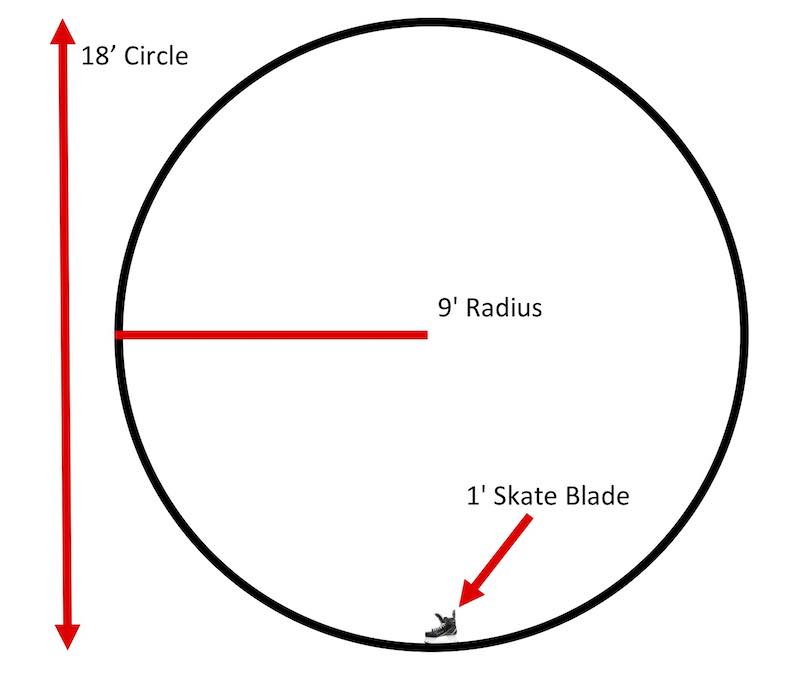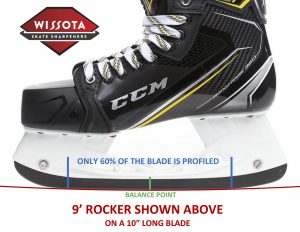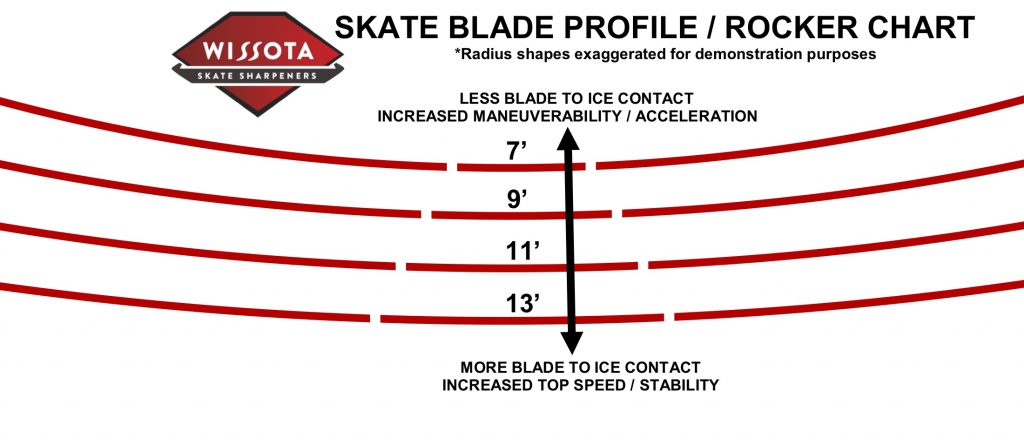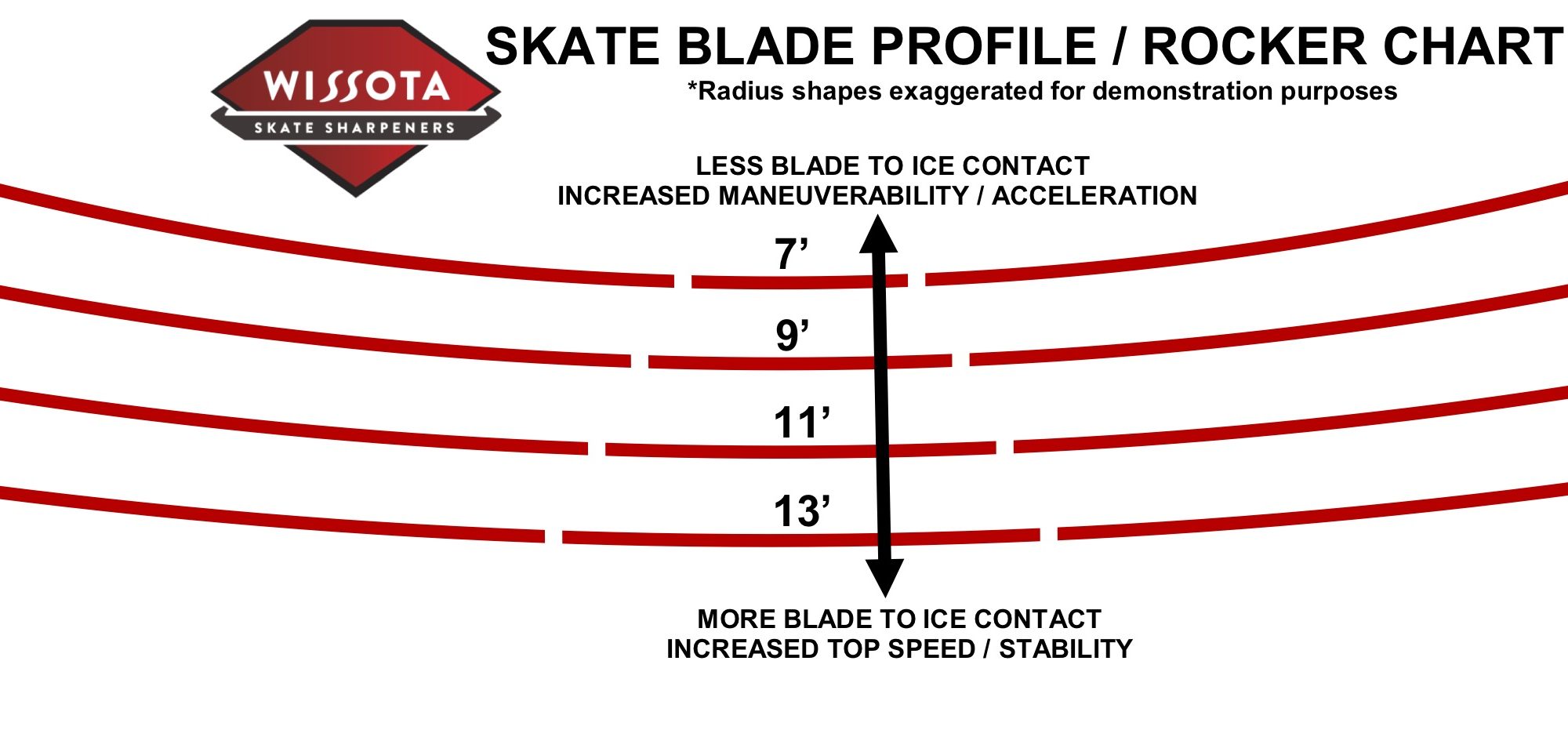WHAT IS A PROFILE / ROCKER?
 Often referred to as the profile, rocker, or contour of your skate blade, these terms all refer to the curvature of your skate blade from heel to toe. Similar to the radius of hollow on the bottom of your skate blade, the profile is measured by radius as well, however this radius is significantly larger and measured in feet instead of fractions of an inch. For example hockey player skate profiles can range from 7′ to 13′ rockers with the most popular being 9′ and 11′, while goalie skates are usually around a 28′ rocker. Typically only 60% of the blade is profiled, centered around the balance point of the skate, which can be placed in the center of the blade or also altered towards the toe or heel of the blade as well for different skating styles. The very front 20% of the skate blade on the toe and very back 20% on the heel are much more rounded to allow for proper starts, stops, and full skating stride extension.
Often referred to as the profile, rocker, or contour of your skate blade, these terms all refer to the curvature of your skate blade from heel to toe. Similar to the radius of hollow on the bottom of your skate blade, the profile is measured by radius as well, however this radius is significantly larger and measured in feet instead of fractions of an inch. For example hockey player skate profiles can range from 7′ to 13′ rockers with the most popular being 9′ and 11′, while goalie skates are usually around a 28′ rocker. Typically only 60% of the blade is profiled, centered around the balance point of the skate, which can be placed in the center of the blade or also altered towards the toe or heel of the blade as well for different skating styles. The very front 20% of the skate blade on the toe and very back 20% on the heel are much more rounded to allow for proper starts, stops, and full skating stride extension.

what profile is best?
A smaller profile (7′) will make less contact with the ice than a larger profile (13′). Less ice contact (7′) allows for greater maneuverability and acceleration, but also digs into the ice more than a larger profile (13′), which means slower top speeds and increased fatigue. More ice contact (13′) provides increased top speed and stability, but decreased agility and maneuverability. Similar to the radius of hollow on your skate blade, there is no right or wrong profile, it all comes down to personal preference and skating style.

new blades / measuring profiles
Brand new skates or brand new blades are going to have some sort of generic profile right from the factory. Different brands use different standard profiles for their blades, but 9′ and 11′ are the most common. Accuracy of these factory blades however can vary depending on the blade manufacturing process. In order to find out what profile is currently on your blades, there are a couple different tools that can be used:
balance point
The exact center point of your blade rocker (lowest point of the blade) is referred to as the balance point. It is most common for the balance point to be in the center, but the balance point can be moved towards the toe or heel of the blade to change the pitch or lean of the skater. Changing the balance point and pitch gives the skater either a natural forward lean or backward lean, depending on how far the balance point is moved. A “forward pitch” actually moves the balance point towards the heel of the blade, naturally leaning the skater forward and causing more knee bend and therefore greater agility but also greater fatigue. Again, no balance point is the correct balance point, it all comes down to personal preference and skating style.
maintaining your profile
Whether you have a custom profile ground onto your blades by a professional or stick with the factory profile on a set of new blades, it is important to maintain that profile through consistent skate sharpening. Profiles can be altered over time either by an unskilled skate sharpener applying inconsistent grinding pressure and speed, or by automatic sharpening machines which are unable to maintain consistent grinding pressure. It usually takes multiple poor skate sharpenings to really alter a profile, but when sharpening it is very important to remember to grind with both consistent speed and pressure so that the blade profile is maintained. Consistently measuring your profiles with either of the tools recommended above is a great way to make sure that you are in-fact sharpening consistently and maintaining your profile.
Questions?
Contact us: (952) 417-6611 sales@wissota.com
